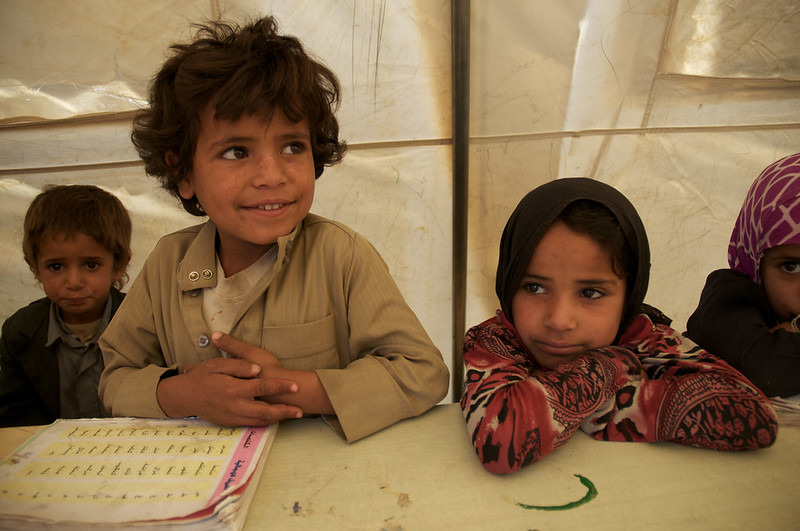Child Poverty in Yemen
 Yemen is currently in the middle of the worst humanitarian crisis in the world. Yemen has been in conflict since 2015, a situation that has devastated its economy. COVID-19 also hit Yemen’s economy hard due to a fall in global prices, weak public infrastructure and a limited ability to cope with extreme climate events. Yemen’s death rate is currently five times the global average. Unfortunately, the crisis Yemen is experiencing most heavily impacts children and puts millions of kids at risk of starvation. Here is more information on child poverty in Yemen.
Yemen is currently in the middle of the worst humanitarian crisis in the world. Yemen has been in conflict since 2015, a situation that has devastated its economy. COVID-19 also hit Yemen’s economy hard due to a fall in global prices, weak public infrastructure and a limited ability to cope with extreme climate events. Yemen’s death rate is currently five times the global average. Unfortunately, the crisis Yemen is experiencing most heavily impacts children and puts millions of kids at risk of starvation. Here is more information on child poverty in Yemen.
The Crisis in Yemen
There is an immense tragedy occurring in Yemen. Estimates have determined that Yemen’s overall poverty rate is 80% and the war has already set back the country’s development by 25 years. In addition to facing the enormous impact of the COVID-19 pandemic, Yemen continues to battle mass outbreaks of preventable diseases such as cholera, diptheria, measles and dengue fever. On top of fighting these diseases, the conflict in Yemen is actively occurring. The war has resulted in the deaths of nearly a quarter of a million people from its start in 2015 to mid-2021. Unfortunately, Yemen’s children are the most vulnerable members of society and this crisis has caused child poverty in Yemen to be a critical issue.
Starvation and Malnutrition
According to UNICEF, 11 million children in Yemen urgently need humanitarian assistance. Child poverty in Yemen is continuing to rise, and more than 2.3 million children could starve by the end of 2021. This represents an unprecedented hunger crisis. Of these 2.3 million, expectations have stated that 400,000 will face acute malnutrition and could die without urgent treatment. Additionally, 1.2 million pregnant and breastfeeding mothers may experience malnourishment by the end of 2021, meaning that over 1 million children will be born in hunger. Between 2015 and 2020, over 3,000 children have been killed as a result of the war. As a result of facing so much trauma and conflict, an astonishing half of the children in Yemen are struggling with depression.
Impact on Education
Beyond the fact that the pandemic and conflict in Yemen are impacting children’s basic needs such as food, education is also under threat. Before the pandemic, 2 million children were out of school and 3.7 million more were at risk of leaving school altogether. Pandemic closures increased the number of kids at risk to 8 million, and teachers are not receiving pay. At least 4.7 million children are in need of educational assistance. Schools lack funds, resources and adequate sanitation, especially for girls. According to UNICEF, Yemen now owes $70 million in stipends to teachers. In addition to the pandemic preventing attendance, the conflict has destroyed about 2,000 schools.
Finding Hope
The Yemenis are resilient and are searching for solutions despite all of the turmoil. Communities are rebuilding their own schools and providing these schools with essential resources. The vast majority of schools in Yemen have no electricity. This means that kids have no access to clean water and sanitation services. The Yemen Emergency Electricity Access Project is working to install solar energy systems in schools. Solar energy can provide sanitary resources to students and the community. It also improves children’s experience in the classroom by providing light and a comfortable environment. This project should help at least 1.3 million people. Meanwhile, the United Nations Development Program (UNDP) put up nine solar microgrids to improve energy access.
In order to combat the mental health crisis in Yemen, social workers are providing mobile counseling. In 2018, UNFPA established six psychological support centers. Since then, these centers provided mobile psychological support to about 18,000 people, and the demand for these services is rising due to both the pandemic and continuing conflict.
Spreading the Word
The crisis in Yemen is vast and will take a united effort to address. One important factor in working to end this crisis is awareness. Social media posts, conversations and contacting U.S. government representatives are all methods to spread the word. While the U.S. did suggest a ceasefire in Yemen, this request will likely go unheeded if it does not take sufficient action to halt military support to the Saudi and Emirati-led coalition. The resilience of the Yemenis and help from the rest of the world can fight child poverty in Yemen and aid in the overarching crisis.
– Jacqueline Zembek
Photo: Flickr
